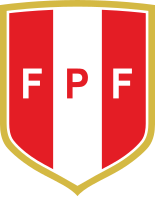
Back منتخب بيرو لكرة القدم Arabic فريق پيرو لكورة القدم ARZ Seleición masculina de fútbol de Perú AST Peru milli futbol komandası Azerbaijani پرو میلّی فوتبال تیمی AZB Tim nasional sépakbola Péru BAN Зборная Перу па футболе Byelorussian Зборная Пэру па футболе BE-X-OLD Национален отбор по футбол на Перу Bulgarian পেরু জাতীয় ফুটবল দল Bengali/Bangla
The Peru national football team (Spanish: Selección de fútbol del Perú), nicknamed La Bicolor, represents Peru in men's international football. The national team has been organised, since 1927, by the Peruvian Football Federation (FPF).[A] The FPF constitutes one of the ten members of FIFA's South American Football Confederation (CONMEBOL). Peru has won the Copa América twice, and has qualified for the FIFA World Cup five times (last appearing in 2018); the team also participated in the 1936 Olympic football competition and has reached the semi-finals of the CONCACAF Gold Cup. The team plays most of its home matches at the Estadio Nacional in Lima, the country's capital.
The team wears distinctive white shirts adorned with a diagonal red stripe, which combine Peru's national colours. This basic design has been used continuously since 1936, and gives rise to the team's common Spanish nickname, la Blanquirroja ("the white-and-red").[4] Peruvian football fans are known for their distinctive cheer ¡Arriba Perú! ("Onward Peru!") and large celebrations.[5] Peru has a longstanding rivalry with Chile.[6]
The Peru national team enjoyed its most successful periods thanks to footballing generations from the 1930s and the 1970s.[7] The 1930s generation led Peru at the inaugural FIFA World Cup in 1930 and won the 1938 Bolivarian Games and the 1939 Copa América, with goalkeeper Juan Valdivieso and forwards Teodoro Fernández and Alejandro Villanueva playing important roles. The 1970s generation qualified Peru for three World Cups and won the Copa América in 1975; the team then notably included defender Héctor Chumpitaz and the forward partnership of Hugo Sotil and Teófilo Cubillas.
The national team's all-time top goalscorer is Paolo Guerrero, with 39 goals, and its two joint most-capped players are Roberto Palacios and Yoshimar Yotún, both with 128 appearances.[8] Since December 2023, Peru is managed by the Uruguayan Jorge Fossati.
- ^ @VarskySports (13 December 2023). "Jorge Fossati 🇺🇾 es el nuevo DT de la Selección de Perú 🇵🇪" (Tweet) (in Spanish). Archived from the original on 14 December 2023. Retrieved 14 December 2023 – via Twitter.
- ^ "The FIFA/Coca-Cola Men's World Ranking". FIFA. 28 November 2024. Retrieved 28 November 2024.
- ^ Elo rankings change compared to one year ago. "World Football Elo Ratings". eloratings.net. 21 November 2024. Retrieved 21 November 2024.
- ^ Cite error: The named reference
Arkivperu.com, La Blanquirojawas invoked but never defined (see the help page). - ^ Foley Gambetta 1983, p. 12.
- ^ "A derby and a debut in South America". FIFA. 10 October 2011. Archived from the original on 26 June 2015. Retrieved 4 July 2015.
- ^ Witzig 2006, p. 349.
- ^ José Luis Pierrend (31 August 2017). "Peru – Record International Players". RSSSF. Archived from the original on 19 June 2018. Retrieved 24 June 2018.
Cite error: There are <ref group=upper-alpha> tags or {{efn-ua}} templates on this page, but the references will not show without a {{reflist|group=upper-alpha}} template or {{notelist-ua}} template (see the help page).
